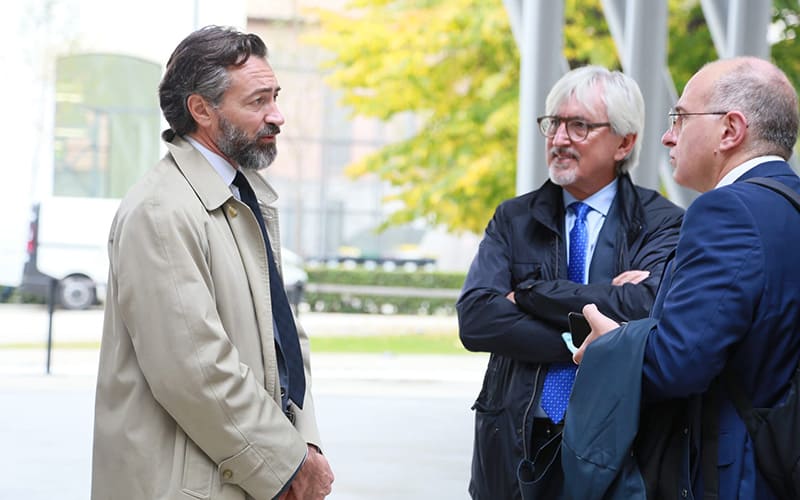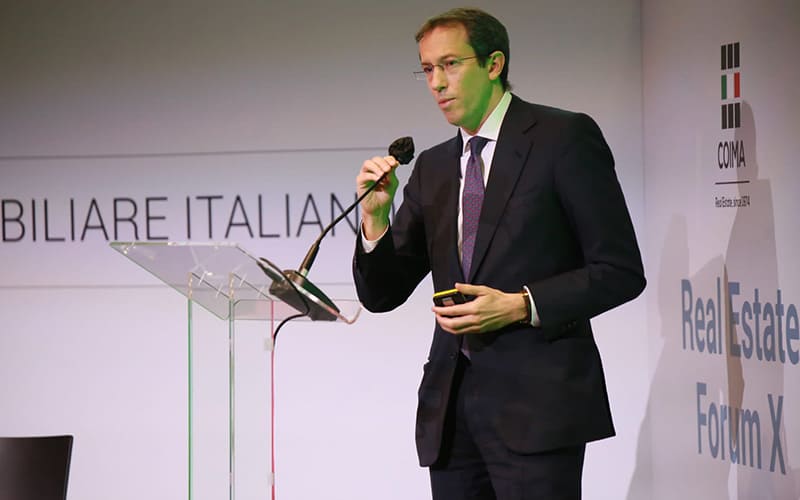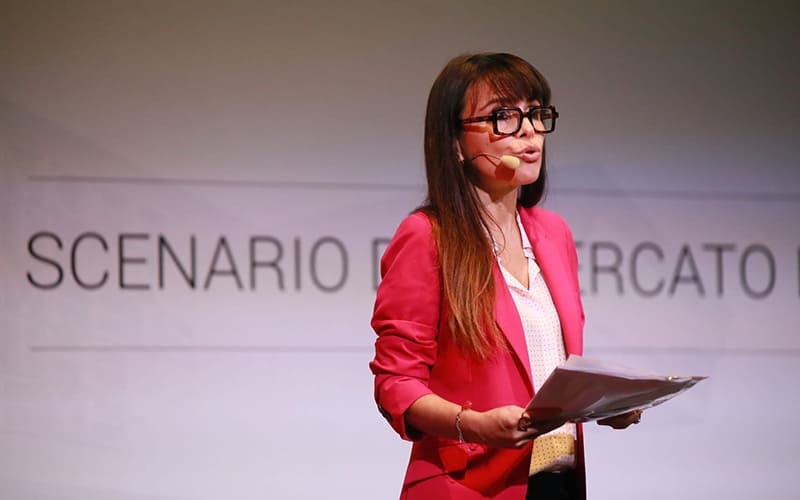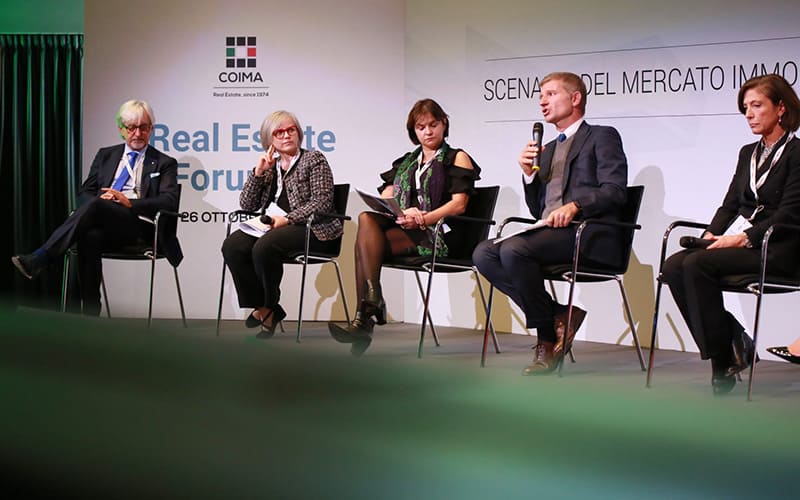Rome, 26 October 2021 - Based on the six missions representing the thematic and structural work areas of the National Resilience Plan (Digitalisation, Production system innovation and competitiveness; Green revolution and ecological transition; Infrastructure for mobility; Education, training, research and culture; Social, gender and land equity; Health), the €54 million capital will involve and generate an impact for Italian cities and the whole country. The figure could exceed €85 billion if investments in infrastructure are included.
This figure emerged during the tenth COIMA Real Estate Forum, an annual event dedicated to in- depth analysis of strategies and investments for land development, organised today in Rome by COIMA, the Italian group leader in the investment, development and management of real estate assets for institutional investors.
NRP, Real Estate and Infrastructure
Urban regeneration is identified by the NRP under its mission 5. But adopting a transversal approach for the missions, identifying investments with a direct and indirect impact on the land regeneration, we obtain a significantly more relevant picture in terms of resources allocated and social and environmental impact. Along with infrastructure projects, urban regeneration projects should amplify and accelerate the plan objectives in line with Next Generation EU. For this reason i) horizontal governance between missions ii) definition of quantitative ESG objectives iii) public-private partnership models iv) simplification of processes and approval procedures are the main elements to activate virtuous urban regeneration operations.
Of the more than €85 billion estimated by COIMA, €54.4 billion could involve the land transformation sector, while approximately €31.5 billion would mainly concern the infrastructure sector.
According to COIMA research, these capitals could start an important process of national land regeneration, currently involving more than 350 million sqm of public real estate assets which need redevelopment. These assets are controlled by public administrations (about 220 million sqm by municipalities, 42 million sqm by central administrations, 78 million sqm by local authorities, eight million sqm by regions and five million sqm by public pension funds and institutes).
Sustainable urban regeneration
Italy can work quickly within this scope to close an important gap with the European average: over 60 year-old buildings are 40 per cent in Italy compared to an EU average of 32 per cent; assets at potential seismic risk are more than 70 per cent in Italy compared to 30 per cent in the EU, with a significant lack of green areas available for each citizen, which in Italy is about 15 per cent against an EU average of 20-30 per cent.
According to COIMA research, bridging these gaps would mean regenerating no less than 100 million square metres with investments of €200 billion in 10 years.
These consequences could activate multiple benefits in many different areas: the environment, by reducing 15 per cent of CO2 emissions in Italy, employment, by creating 200-300,000 jobs yearly, and the economy, by reducing regional differences, an increase in tourism data and an important induced activity, across various sectors.
A further development driver is the design of ESG-compliant buildings, which can play a crucial role in sustaining long-term growth, by stimulating economies through investment, and by supporting ESG European initiatives to build a more sustainable economy in line with the EU framework for the European Green Deal.
This historical extraordinary and unrepeatable epoch allows Italy to adopt a systemic and virtuous institutional approach that, in other European countries, allowed the development of excellent national companies of adequate size to meet their national needs and compete internationally. The government, CDP, Ferrovie, Poste Italiane, Intesa San Paolo, Unicredit, and our institutional investors (social security and pension funds, insurance companies, banking foundations) are examples of parties that could work with the private sector to create a historic industrial plan for Italy that would fuel competitiveness and economic and cultural development.
Rome, an opportunity for the coming years
As emerged from the Forum, Rome is the city that, with its central position in Italy and the Mediterranean basin, can seize significant opportunities in the future. Acceleration is possible thanks to events that will involve the city - such as the Jubilee, Ryder Cup, European Aquatics Championships and its candidature for Expo 2030 - which could be a driving force for growth and development.
Milan, which launched an urban regeneration programme in 2000, enabled the creation of a production chain of professionals and companies that have gained 20 years of experience and represent an important national resource.
As recently highlighted in a Scenari Immobiliari report, “Rome can count on a historical and architectural heritage that is unique in the world, a tourist attractiveness that has brought 46.5 million presences in the city in 2019, with 1,036 hotels and 51,000 rooms, a national transport hub such as Fiumicino from which 43.5 million people have transited, green areas and low density, with 162 sqm of green space per inhabitant. These factors set Rome in fourth place in Europe in terms of the city’s overall level of attractiveness, and one of the five most important urban centres on the continent.”
COIMA Founder and CEO Manfredi Catella said: “Italy has a historical vocation to develop extraordinary cities. Today, with the main public and private institutions’ systemic approach, it is possible to prepare an industrial plan for land redevelopment which establishes a new Italian cultural and economic development model and allows the growth of excellent national companies that can serve the country and compete internationally. With the support of the main Italian institutions, the COIMA ESG City Impact Fund is on its way to exceed 500 million in fundraising destined to invest in urban regeneration programmes with an economic impact of more than €2 billion in partnership with qualified institutions and operators.”
The Forum
The Forum streamed more than 500 industry players, representing about 60 leading Italian and international institutional investors from Asia, America, Canada, Middle East, Europe and Italy.
After Minister of Ecological Transition, Roberto Cingolani’s opening speech, Manfredi Catella (COIMA Founder and CEO) talked about Sustainable Urban Regeneration. This was followed by an analysis of the economic scenario and the Italian real estate market with Komal Sri-Kumar (President, Sri-Kumar Global Strategies, Inc.) and Gabriele Bonfiglioli (COIMA Managing Director, Investment Management). Moderated by journalist Mariangela Pira, a round table discussion dealt with the “National Recovery & Resilience Plan: land regeneration as an industrial engine of the Italian economic recovery" with speakers Silvana Chilelli (CEO, Eurizon Capital Real Asset SGR), Carla Patrizia Ferrari (CFO, Fondazione Compagnia di San Paolo), Paolo Gencarelli (Head of Group Real Estate, Poste Italiane), Francesca Maione (Member of the Board of Directors, INAIL),











